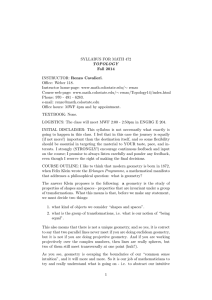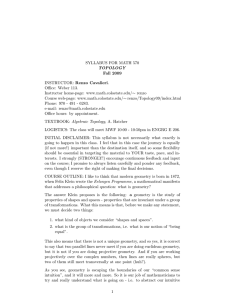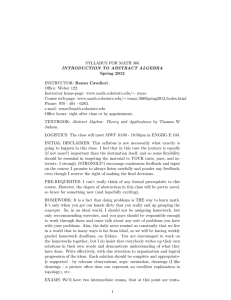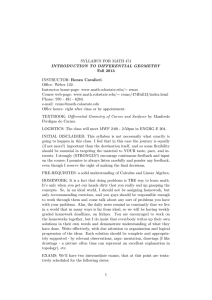SYLLABUS FOR MATH 472 TOPOLOGY Fall 2010 INSTRUCTOR: Renzo Cavalieri.
advertisement
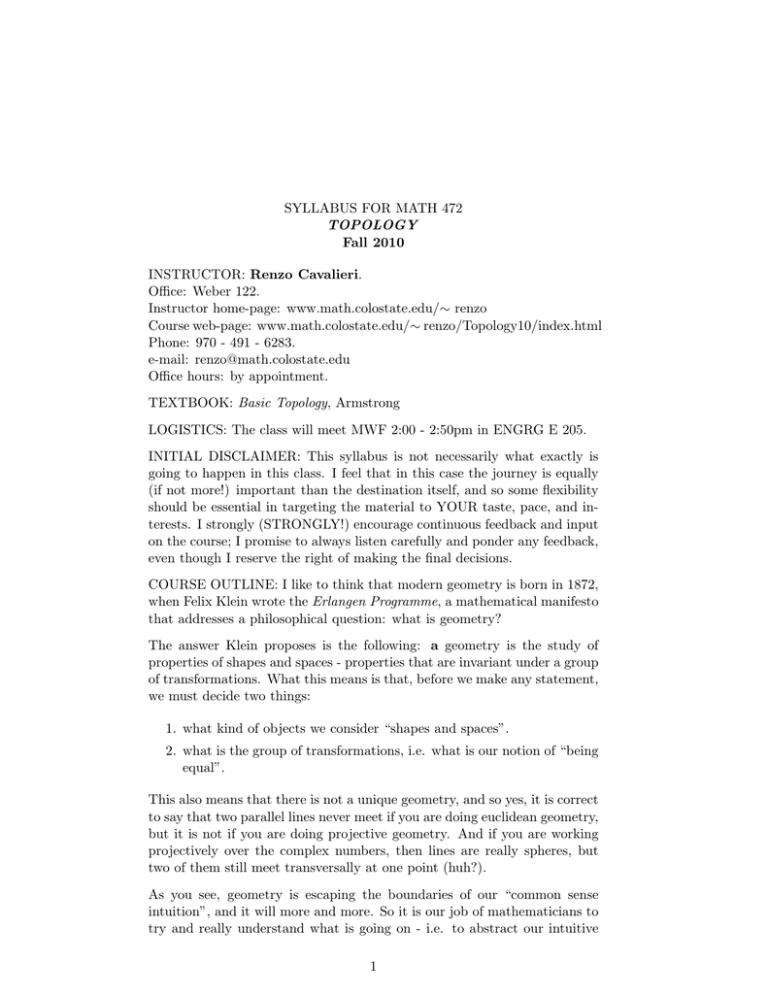
SYLLABUS FOR MATH 472 TOPOLOGY Fall 2010 INSTRUCTOR: Renzo Cavalieri. Office: Weber 122. Instructor home-page: www.math.colostate.edu/∼ renzo Course web-page: www.math.colostate.edu/∼ renzo/Topology10/index.html Phone: 970 - 491 - 6283. e-mail: renzo@math.colostate.edu Office hours: by appointment. TEXTBOOK: Basic Topology, Armstrong LOGISTICS: The class will meet MWF 2:00 - 2:50pm in ENGRG E 205. INITIAL DISCLAIMER: This syllabus is not necessarily what exactly is going to happen in this class. I feel that in this case the journey is equally (if not more!) important than the destination itself, and so some flexibility should be essential in targeting the material to YOUR taste, pace, and interests. I strongly (STRONGLY!) encourage continuous feedback and input on the course; I promise to always listen carefully and ponder any feedback, even though I reserve the right of making the final decisions. COURSE OUTLINE: I like to think that modern geometry is born in 1872, when Felix Klein wrote the Erlangen Programme, a mathematical manifesto that addresses a philosophical question: what is geometry? The answer Klein proposes is the following: a geometry is the study of properties of shapes and spaces - properties that are invariant under a group of transformations. What this means is that, before we make any statement, we must decide two things: 1. what kind of objects we consider “shapes and spaces”. 2. what is the group of transformations, i.e. what is our notion of “being equal”. This also means that there is not a unique geometry, and so yes, it is correct to say that two parallel lines never meet if you are doing euclidean geometry, but it is not if you are doing projective geometry. And if you are working projectively over the complex numbers, then lines are really spheres, but two of them still meet transversally at one point (huh?). As you see, geometry is escaping the boundaries of our “common sense intuition”, and it will more and more. So it is our job of mathematicians to try and really understand what is going on - i.e. to abstract our intuitive 1 geometric notions to a more general context. Topology is a fun branch of geometry to study in order to accomplish such a goal. In fact, in topology, Klein’s group of transformations is simply huge! Two geometric shapes are considered equal if there is a bijective, (open), continuous function between them. Some people like to call topology “rubber geometry”, in the sense that is the stdy of objects that are made of an extremely stretchable and bendable rubber. This means, for example, that a triangle, a square and a circle are all the same. So even searching for properties to study is a chore to begin with! (lengths, areas, angles, number of sides...all goes topsy turvey if a triangle is the same as a circle). Properties that remain the same under such a huge flexibility are called topological invariants. We will spend the first month or so of this course talking about basic concepts in topology and the very first topological invariants. These invariants are extremely coarse, but learning about them will be a little bit of a warming ourselves up to this kind of thinking. Then I’d like to move on and spend the rest of the semester on algbraic topology, where the topological invariants are algebraic objects (like numbers, groups, etc). In order to assure that these algebraic objects are indeed invariant under homeomorphisms, a very successful technique is to show that they form a functor. This is a key idea in modern mathematics and we will try to become really familiar with it. We will definitely talk about the fundamental group, and we will go a bit into covering theory. If we get lucky and speedy I will probably want to talk about the topological point of view on Riemann Surfaces, just because I like them very much. And about the connection to the representation theory of symmetric groups. PRE-REQUISITES: I can’t really think of any formal prerequisite to this course, besides a solid intuition of the notion of continuity. However, the degree of abstraction in this class will be pretty high, so it will certainly be useful if you have seen a fair amount of “modern” mathematics. HOMEWORK: It is a fact that doing problems is THE way to learn math. It’s only when you get our hands dirty that you really end up grasping the concepts. So, in an ideal world, I should not be assigning homework, but only reccommending exercises, and you guys should be responsible enough to work through them and come talk about any sort of problems you have with your problems. Alas, the daily news remind us constantly that we live in a world that in many ways is far from ideal, so we will be having weekly graded homework deadlines, on fridays. You are encouraged to work on the homeworks together, but I do insist that everybody writes up their own solutions in their own words and demonstrate understanding of what they 2 have done. Write effectively, with due attention to organization and logical progression of the ideas. Each solution should be complete and appropriately supported - by relevant observations, argu- mentation, drawings (I like drawings - a picture often time can represent an excellent explanation in topology), etc. EXAMS: We’ll have two intermediate exams, that at this point are tentatively scheduled for the following dates: • Oct 11th; • Nov 5th. FINAL EXAM: the final exam may be a regular exam, a take home, or a project...I don’t know yet. I’ll let you know details plenty in advance. COURSE GRADES. Here is the chart of how grades will be decided: • 30% for the final exam. • 25% for each of the two intermediate exams. • 15% for homework. • 5% for class attendance and participation. MISCELLANEOUS: Make up quizzes and exams can be arranged, but please, please, please do notify me beforehand. I reserve the right to refuse to offer a makeup if I am asked after the event itself. In case of special needs I am willing to make special arrangements about homework, attendance policy etc etc but again I require that you discuss such arrangements “before the fact”. CLASS PARTICIPATION: I consider class participation extremely important. I encourage you to make questions, remarks, comments. I will often ask you guys to come up to the blackboard to solve exercises. And yes, questions. Ask lots of questions, don’t be afraid...as usual, if you are confused, most likely other people are, and everybody is just being shy. Worse case scenario, if I feel I can’t afford the time to answer your question during class time, we will discuss it after class. Remember: NO QUESTION WILL EVER BE HELD AGAINST YOU! ADA STATEMENT: the American with Disabilities Act requires that reasonable accomodations be provided for students with physical, cognitive, systemic, learning and psychiatric disabilities. Please contact me at the beginning of the course to discuss any such accomodations you may require for the course. 3
